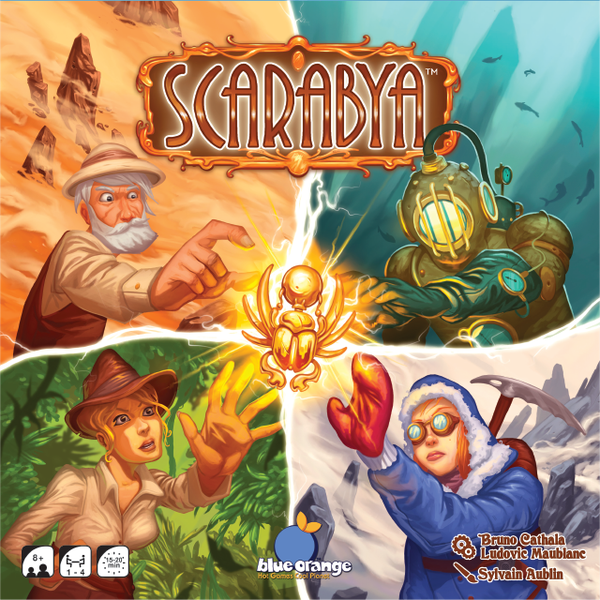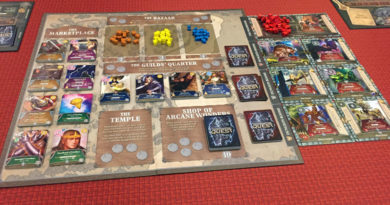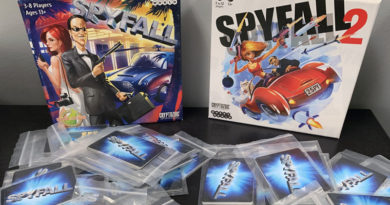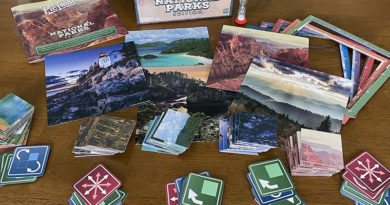Sail into the Blue Lagoon for family fun
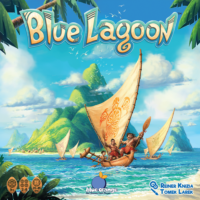
One look at the box art for Blue Lagoon and we know exactly what you’ll think.
That’s because we, and everyone else we’ve shown the game to has said the exact same thing, “Is this Moana, the Board Game?”
Nope, it’s not.
It’s Blue Lagoon – another Gen Con 2018 release from Blue Orange Games!
And while there’s no “Maui, shapeshifter, Demigod of the wind and sea, hero of men” to be found anywhere in Blue Lagoon, you will find lots of island settlers and colorful huts to dot the board.
Blue Lagoon is a family board game that combines area control and set collection in a fulfilling experience. It’s a light strategy board game that requires a bit of planning as you set out to settle villages, expand your routes, and gain resources for points.
It’s time to see if it’s a journey your family would like to set sail on.
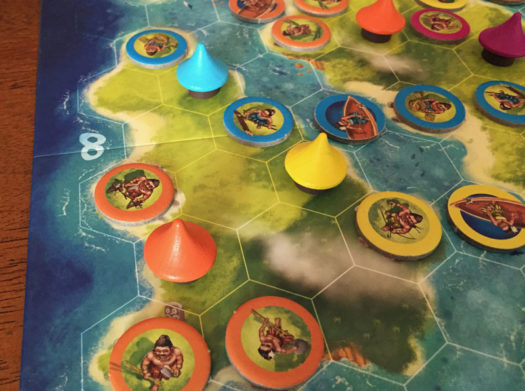
How to play Blue Lagoon
A game of Blue Lagoon is played over two phases. While both phases initially may look the same, players will find the slight differences can make a big difference in the final results.
After setting out the board, players place all resources in a bag and randomly draw and place them on the stone circles across the various islands. Then players take the Villages and Settlers in the color of their choice and they’re ready to play.
The Settler tokens are double-sided with images depicting a land side and a boat side.
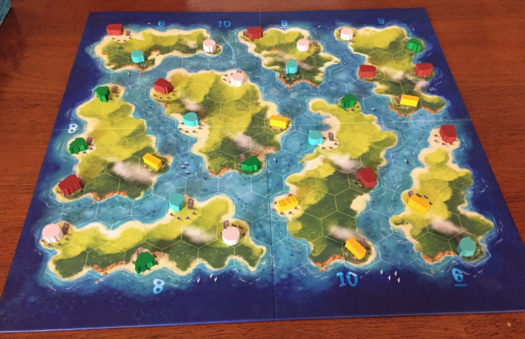
Phase 1 – Exploration
During Exploration, players take turns placing either a Village or a Settler on a space on the board. On their first turn, a player must place one of their Settlers in an unoccupied sea space (boat side up) – since the settlers can’t get on an island until they sail there.
On subsequent turns, players can choose to place one Settlers either on land or sea or a Village on the land. However, to place a Settler or Village on land, the player must place it adjacent to one of their Settler tokens or Villages already on the board.
If the player places a Settler or Village on a space with a resource, they gain that resource.
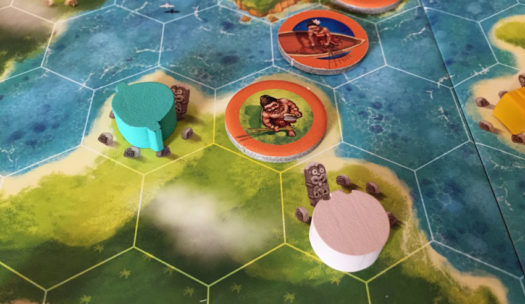
When all the resources have been collected or all players have placed their Settlers and Villages on the board, the Exploration phase ends.
Then players score their points.
The included score pad shows how players score points.
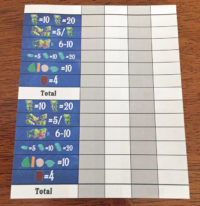
- Islands: Players with at least one piece on all 8 islands scores 20 points. Players with a piece on 7 islands scores 10 points.
- Links: Players earn points for their continuous chain of pieces that connects the most islands. They score 5 points for each island linked in this chain.
- Majorities: The player with the most pieces on each island scores 6, 8, or 10 points as shown next to that island on the board. If there’s a tie, the points are split.
- Resources: Players score for sets of resources they collect – 4 of a matching resource earns 20 points, 3 of a resource scores 10 points, and 2 of a resource scores 5 points. In addition, if they have at least one of the 4 resource types, they score an additional 10 points.
- Statuettes: Players score 4 points for each statuette they’ve collected.
Phase 2 – Settlement
To begin the Settlement phase, all pieces except for Villages are removed from the board. If there are Villages on stone circles, those are also removed and put back in the box. Any Villages not played in the Exploration phase are also placed back in the box.
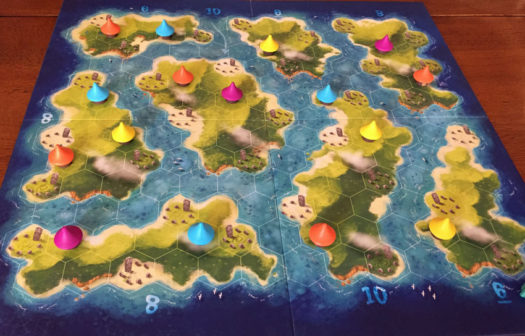
Then, like at the beginning of the game, all resources are placed in the bag, randomly drawn, and placed on the stone circles across the various islands.
During this phase, players will only place Settlers on the board. And they must place them only on unoccupied spaces next to a piece they already have on the board. This means when they begin, they’ll have to place their first Settler next to one of their established Villages.
Unlike in the Exploration phase, during Settlement players can only place a piece in the sea if it’s next to one of their existing pieces.
Like the first phase of the game, this phase ends when all the resources have been collected or all players have placed all their Settlers on the board.
Players score points just like after the first phase. Then points from phase 1 and phase 2 are added together and the player with the most points wins!
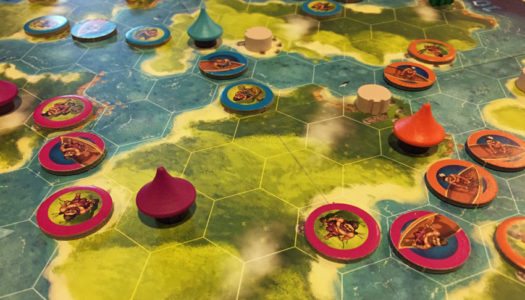
Can the whole family enjoy Blue Lagoon?
Like every game we’ve played by Blue Orange Games, Blue Lagoon is a great family board game. The recommended age for players is 8+ but we can see many younger kids wanting to join in the fun of Blue Lagoon as well.
While younger kids may not grasp the strategic aspects of optimizing their score, they’ll totally understand how to place pieces and collect resources. And they’ll love making chains of their pieces from island to island. (And it’s okay if they listen to the Moana soundtrack while playing.)
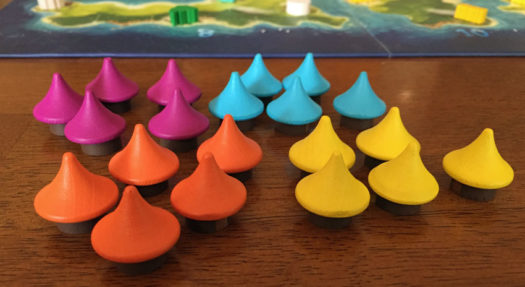
Overall, it’s a quick placement game with lots of ways to score points. In fact, there are so many ways to score points it may be hard to know what to focus on. Plus, you won’t be able to do everything you want.
Sure, getting pieces on all 8 islands scores a lot of points, but you may have to sacrifice making a long chain of linked islands to achieve it. Likewise, collecting matching resources is great, but depending on where they randomly appear, you may have to forego getting as many as you want so you can get pieces on all the islands you want.
Then there’s the factor of what the other players are doing. They’ll be swiping in to grab resources you have your eye on or blocking your way in linking islands. And 4-player games mean there are plenty of opponents to keep an eye on as well.
All that means for such simple game player, there are plenty of choices to be made throughout the game.
And that’s where we were pleasantly surprised!
When we first took a look at Blue Lagoon and read the rules, we weren’t drawn in. Placing pieces looked too simple and the 2 phases looked too similar and repetitive.
But as soon as we played our first game, we were hooked!

There’s more depth in Blue Lagoon than we first realized and that’s a great thing.
The first half of the game sets up things strategically for the second half of the game. Since in the second phase, players can only launch out from where they placed their Villages in the first phase, getting good locations is key to establishing a good run in the second phase.
All these choices keep players thinking throughout the game. Yet, at the same time the choices aren’t overwhelming. They’re simple enough that players’ turns go by very quickly and before you know it, the phase and then the game are over.
Plus, there’s also enough randomness to keep the game competitive for all players. That’s because the random placement of the resources in both phases will impact your plans. And that means there’s enough variety for repeat plays.
All these combined together make Blue Lagoon a light strategy board game that’s great for families.
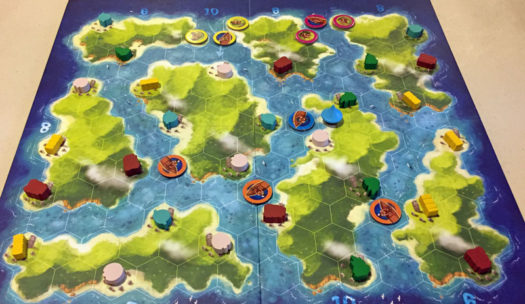
How does Blue Lagoon score on our “Let’s Play Again” game meter?
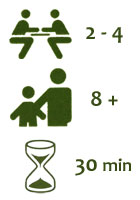 Blue Lagoon gets a solid score on our “let’s play again” game meter for all the reasons mentioned above. It has a great balance of luck and strategy to keep it interesting. Players turns go by quickly, so everyone stays engaged the whole time and the game doesn’t last too long.
Blue Lagoon gets a solid score on our “let’s play again” game meter for all the reasons mentioned above. It has a great balance of luck and strategy to keep it interesting. Players turns go by quickly, so everyone stays engaged the whole time and the game doesn’t last too long.
Players also learn how their opponents play in phase 1 to adjust their play during phase 2. So, by the time the game ends, players are ready to give it another shot and try a different approach.
If you’re after a light strategy game with and island theme for your whole family, we’d recommend you sail away with Blue Lagoon.
We’d like to thank Blue Orange Games for a review copy of Blue Lagoon.

